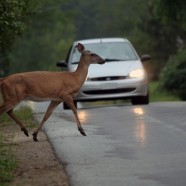
The number of deer-related accidents on Maryland roadways is steadily increasing, costing motorists more than $10 million annually and raising significant safety concerns. As deer populations and traffic volume continue to increase, the problem will become more costly and more widespread. Current mitigation measures (roadside reflectors, fender-mounted whistles) are being deployed by various state and local agencies in hopes of reversing the trend. However, these measures have yet to be proven effective in reducing deer-vehicle collisions. Before even more funds are spent, it is advisable to first address several fundamental, yet unanswered, questions regarding deer behavior and accident locations:
- Why do deer cross the road?
- How much time do they spend on the rights-of-way and interchange areas?
- Are they attracted to the rights-of-way and medians as a source of food, cover, etc?
- How do they gain access to the rights-of-way?
- Are there certain areas where they prefer to cross, where underpasses or overpasses would be effective?
- Do certain deer cross the road more frequently than others?
- Are there certain landscape features that act to “funnel” deer to specific access points along MD roads?
- Do roadside reflectors actually deter deer from entering a roadway?
Accident reporting is another area where critical information is unavailable. It has been estimated that only 15% of all deer-vehicle accidents are reported back to the MD State Highway Administration (SHA). Furthermore, accident location data exists at various levels of government and is not compiled and analyzed as a whole. This means that (potentially) hundreds of thousands of state tax dollars are being spent on mitigation measures that are deployed and sited based on a small fraction of the actual data. For mitigation measures to be used in a more cost-effective manner, a greater effort must be made to collect and analyze all available datasets. We are beginning this effort now with initial support from SHA.
PROJECT: We initiated a project with SHA that addresses the current problems and provides a framework for developing effective strategies to reduce deer-vehicle collisions. The project is designed to determine the magnitude of the problem and to gain new information regarding deer movement on and around our roadways. But we need additional funding to pursue all of the project goals. Three goals have been established:
Create a central “Deer Strike” office that will compile and analyze accident reports/carcass removals using a Geographic Information System (GIS) – Underway.
2. Place GPS/PTT collars on a sample of deer to continuously monitor their movements near major roadways – Future Objective, requires funding.
3. Create a public access website that will display accident locations/deer-tracking data and be used for interactive mapping purposes and public information – Future Objective, requires funding.
With this framework in place, we will be able to provide SHA with the locations of accident ‘hotspots’ and how deer in those areas are gaining access to the roadway. With this information, SHA will then be able to develop focused mitigation measures targeted at the actual problem areas, thereby saving the state time and money.
The following graphic illustrates the “hot spots” of deer-vehicle accidents in Howard County, MD. It is fairly obvious where it would be most effective to target mitigation measures. These are the kinds of analyses should conduct throughout the state. By targeting mitigation measures at the most critical areas, and by learning as much as possible about deer behavior in relation to Maryland roads, we believe that the deer vehicle accident rate can be reduced and that funds could be saved by doing these analyses BEFORE additional mitigation measures are implemented.
The Maryland State Highway Administration Funded the initial stage of this project, and Earthspan created and implemented a state wide reporting system. Md. SHA has been unable to fund further development of a system to reduce the number of deer vehicle collisions in Maryland.
